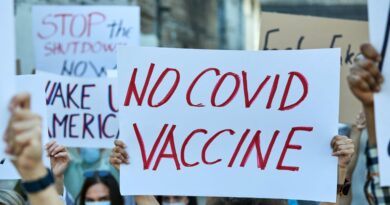Doctors Criticize Fauci for Saying COVID Vaccines Induce ‘Temporary’ Menstrual Irregularities

To receive Global Research’s Daily Newsletter (selected articles), click here.
Follow us on Instagram and Twitter and subscribe to our Telegram Channel. Feel free to repost and share widely Global Research articles.
***
Dr. Anthony Fauci’s recent comments on menstrual irregularities met with serious rebuttal from gynecologists, who say COVID-19 vaccines should not have been injected into pregnant women without adequate safety testing.
“Well, the menstrual thing is something that seems to be quite transient and temporary, that’s one of the points,” Fauci said in an appearance on Fox News on July 25, upon being asked about the effect of vaccines on menstrual cycles.
“We need to study it more,” Fauci added.
Fauci is the director of the National Institute of Allergy and Infectious Diseases (NIAID) and has been a frontman for COVID vaccine information in the United States.
Dr. Christiane Northrup MD, a former fellow in the American College of Obstetricians and Gynecologists, remarked to The Epoch Times on Fauci’s comments:
“Unfortunately the menstrual problems we are seeing are far from transient and temporary. Many women have been bleeding daily or having heavy, irregular, painful periods for an entire year. And some of these are well past menopause. Something is way off here. ”
Dr. James Thorp is an extensively published 69-year-old physician MD board-certified in obstetrics and gynecology, as well as maternal-fetal medicine, who has been practicing obstetrics for over 42 years.
“The significant and dramatic changes in menstrual patterns occurring after COVID-19 vaccines should not be marginalized. It is indicative of major adverse effects on women of reproductive age. The stakeholders claimed that the vaccine would remain at the injection site in the deltoid muscle. This was misinformation. The lipid nanoparticles (LNP’s) are now known be distributed throughout the entire body and to be concentrated in the ovaries according by at least two studies. Schadlich and colleagues demonstrated concentration of the LNP’s in ovaries of different mouse species and Wistar rats, in vivo, in vitro and by sophisticated microscopic imaging in 2012,” he told The Epoch Times.
A lipid nanoparticle is an extremely small particle, a fat-soluble membrane that is the cargo of the messenger RNA.
Pfizer’s Internal Documents
Pfizer’s internal documents, obtained via the Freedom of Information Act, show a 118-fold increase in the concentration of LNPs from the time of injection to 48 hours.
“The LNP’s are known to include toxic substances including polyethylene glycol and pseudo-uridinated mRNA. The limited number of ovum in the ovaries (about 1 million) are exposed to potentially toxic substances and could potentially have catastrophic effects on human reproduction,” Thorp said.
“The stakeholders claimed that the pseudo-uridinated mRNA could not be reverse transcribed into the human DNA. This was misinformation,” he added, referring to a Swedish study published in February 2022 that concluded that Pfizer’s COVID-19 vaccine is able to enter human liver cells and is converted into DNA.
Thorp and former Pfizer VP Michael Yeadon believe that the medical industrial complex had unequivocal evidence on the vaccine’s danger in pregnant women.
“This is proven not only by VAERS but also by Pfizer’s own internal document ‘Pfizer 5.3.6 post-marketing experience’” Thorp said.
Within the first 90 days of trials, there were 1,223 deaths, multiple severe adverse effects, and a 45 percent complication rate in pregnancy cases (274) that occurred in vaccinated mothers (124).
The 2012 study, mentioned by Thorp earlier, says that after testing with different mouse species and Wistar rats, “a high local accumulation of nanoparticles, nanocapsules and nanoemulsions in specific locations of the ovaries was found in all animals.”
Yeadon believes that the pharmaceutical industry “definitely knew,” since 2012, that the lipid nanoparticles would accumulate in the ovaries of women that took the vaccines.
“No one in the industry or in leading media could claim ‘they didn’t know about these risks to successful pregnancy,’” Yeadon told The Epoch Times in April.
Sidestepping Responsibility
Northrup fears that there could be much more data related to reproductive damage that hasn’t been discovered yet.
“The phrase ‘this requires more study’ whilst downplaying the current evidence of harm is a common way to discount the experience of thousands of women. Unfortunately, academic doctors do this all the time as a way to sidestep responsibility for the untoward effects of their treatments,” Northrup said.
“The female menstrual cycle is considered a vital sign as important as blood pressure and body temperature when it comes to health assessment. Our initial findings of bleeding and decidual cast shedding in women who have been exposed to those who have had the experimental injection suggest that what we’ve seen so far is just the tip of the iceberg. The reproductive effects of this shot could be far worse than we’ve been led to believe,” Northrup previously told The Epoch Times.
Tiffany Parotto, lead researcher of MyCycleStory, a survey that found many problems in women after they took the COVID vaccines, told The Epoch Times in May that she was distressed about the censorship and deletion of a Facebook group of about 21,000 members where women were talking about their menstrual irregularities.
Fauci’s office did not respond to a request for comment by press time.
*
Note to readers: Please click the share buttons above or below. Follow us on Instagram and Twitter and subscribe to our Telegram Channel. Feel free to repost and share widely Global Research articles.
Enrico Trigoso is an Epoch Times reporter focusing on the NYC area.
Featured image is from Ghion Journal
This article has been archived for your research. The original version from Global Research can be found here.


